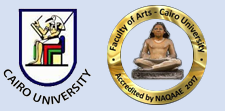عنوان المقال عربي
جماليات التخفي في تغريبة بني حتحوت إلى بلاد الشمال للكاتب مجيد طوبيا
Document Type
Original Study
Subject Area
Language and Literature
Keywords English
Concealment, mystery, the estrangement of Bani Hatoot to the north, Majid Toubia, the absent text
كلمات مفتاحية عربي
التخفي، الغموض، التغريبة، تغريبة بني حتحوت إلى بلاد الشمال، مجيد طوبيا
Abstract English
The concealment enriches the literary text aesthetically and semantically, as through it the novelist launches into the strange and the surprising, and it is one of the effective elements in embodying the complexity of reality. The concealment was used to indicate the true motives of human existence and its relationship with oneself and others. Thus, concealing the truth and highlighting its opposite is the primary characteristic of embodying this element and revealing it. Concealment has its own code that is manifested in the characters of the novel, its events, time, and place. The novelist uses concealment to free the narrative from unilateral control, leaving room for interpretation and multiple readings, highlighting its artistry and beauty. One of the benefits of concealment is that it attracts the attention of the recipient, prompting them to follow the course of the story and etching the event into their memory. It also contributes to condensing the narrative. The novelist resorts to concealment to escape the constraints of censorship and to deviate from the deteriorating reality, expressing the painful truth through the use of language duality, irony, concealment, innuendo, and indirect satire, The concealment constitutes a distinctive feature in the novel "Tughrība Banī Haṭḥūṯa" to the lands of the north, where Majīd Ṭūbyā adopted it as a strategy that had a significant impact on shaping the intellectual and philosophical horizon of the text. He resorted to the phenomenon of concealment to reveal historical truths and educate the recipient about their history, in order to predict their future. Majīd Ṭūbyā excelled in re-reading and weaving history literarily, and his ability to engage the reader in deducing hidden meanings and questioning the reasons that led to those results. His aim in re-reading history was also to show national identity in the face of challenges by projecting the present onto the past, and to attract recipients to re-read history by facilitating the course of events.
الملخص العربي
التخفي يثري النص الأدبي ثراءً جماليًا ودلاليًا، فمن خلاله ينطلق الروائي إلى الغريب والمفاجئ، كما أنه من العناصر الفعالة لتجسيد تأزم الواقع، واستخدمت التغريبة التخفي للدلالة على نوازع حقيقة الإنسان ووجوده في الحياة وعلاقته بذاته وبالآخرين؛ وبهذا فإن إخفاء الحقيقة وإبراز نقيضها هي السمة الأولى لتجسيد هذا العنصر وإظهاره، فالتخفي له شفرة خاصة تتجلى في شخصيات الرواية وأحداثها وزمانها ومكانها. ويستخدم الروائي التخفي ليحرر السرد من السيطرة الأحادية، ليترك مساحة للتأويل وتعدد القراءات والرؤى، فتبرز فنيتها وجماليتها، ومن فوائد التخفي أيضًا أنه يجذب انتباه المتلقي، ويدفعه لمتابعة مجريات الحكاية، ويخلد الحدث في ذاكرته، كما أنه يسهم في اختزال السرد. ويلجأ الروائي للتخفي للهرب من قيود الرقابة، والانزياح عن الواقع المتردي، فهو يصرح بالحقيقة المؤلمة من خلال استخدام ازدواجية اللغة، واستعمال التورية والتخفي والكناية والتعريض؛ لإيصال شفرات ساخرة بأسلوب غير مباشر. ويشكل التخفي سمة مميزة في رواية تغريبة بني حتحوت إلى بلاد الشمال، حيث اتخذ منه مجيد طوبيا استراتيجية كان لها أثر مهم في تشكيل الأفق الفكري الفلسفي للنص، ولجأ إلى ظاهرة التخفي لكشف الحقائق التاريخية، وتوعية المتلقي بتاريخه؛ حتى يتنبأ بمستقبله، وقد تفرد مجيد طوبيا في إعادة قراءة التاريخ ونسجه أدبيًا، وقدرته على إشراك القارئ في استنباط الدلالات الخفية، والسؤال عن الأسباب التي أدت إلى تلك النتائج. وكان هدفه أيضا من إعادة قراءة التاريخ إظهار الذات القومية في مواجهة التحديات، من خلال إسقاط الحاضر على الماضي، وكانت غايته كذلك من إعادة قراءة التاريخ جذب المتلقين لإعادة قراءة التاريخ من خلال تيسير سير الأحداث.
Recommended Citation
Al-Didamoni, Ahmed Al-Didamoni Mohamed Ismail
(2024)
"The aesthetics of concealment in the migration of the Bani Hathut to the countries of the north by the writer Majid Toubia,"
Journal of the Faculty of Arts (JFA): Vol. 84:
Iss.
4, Article 1.
Publication Date
10-1-2024


